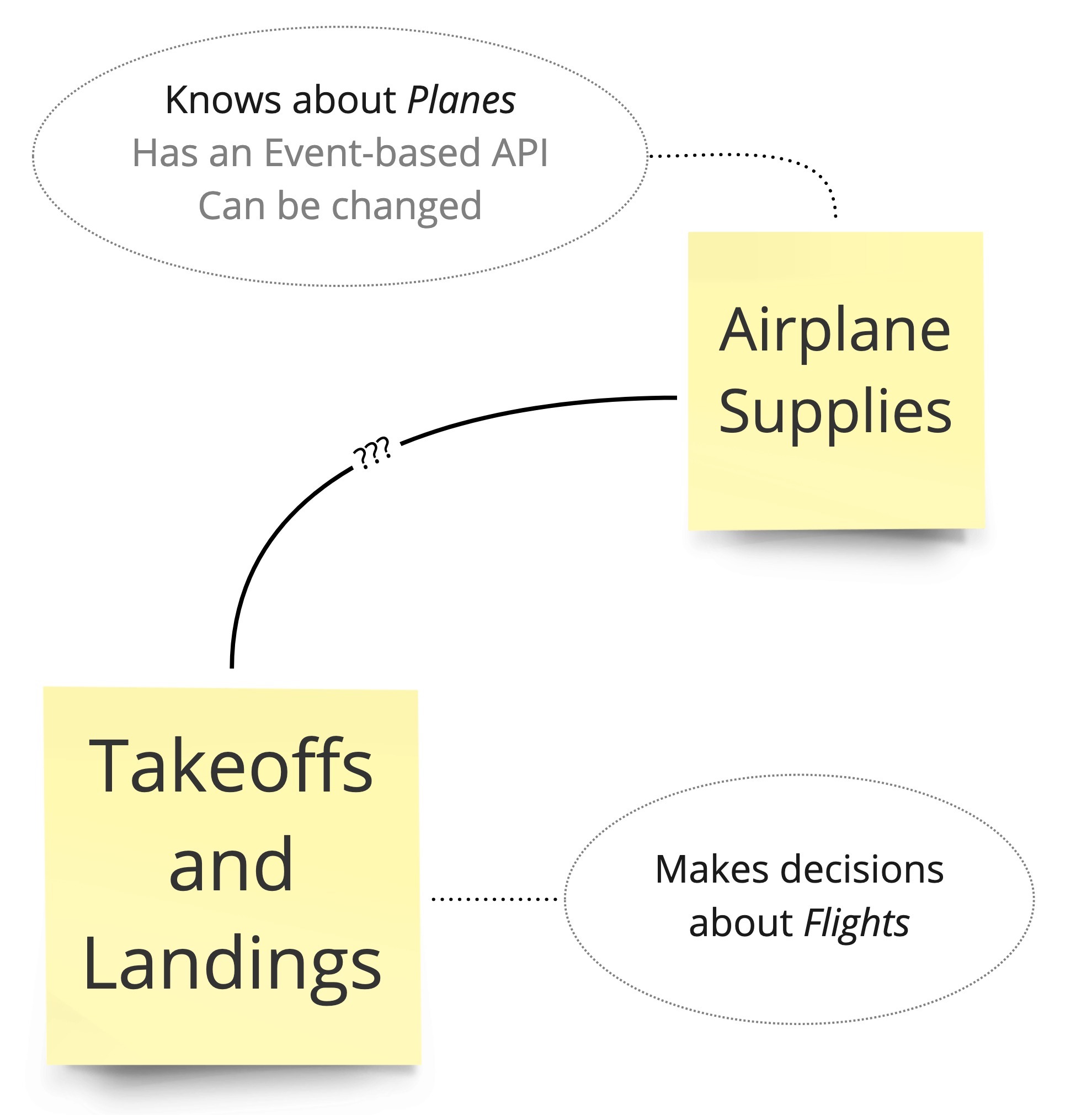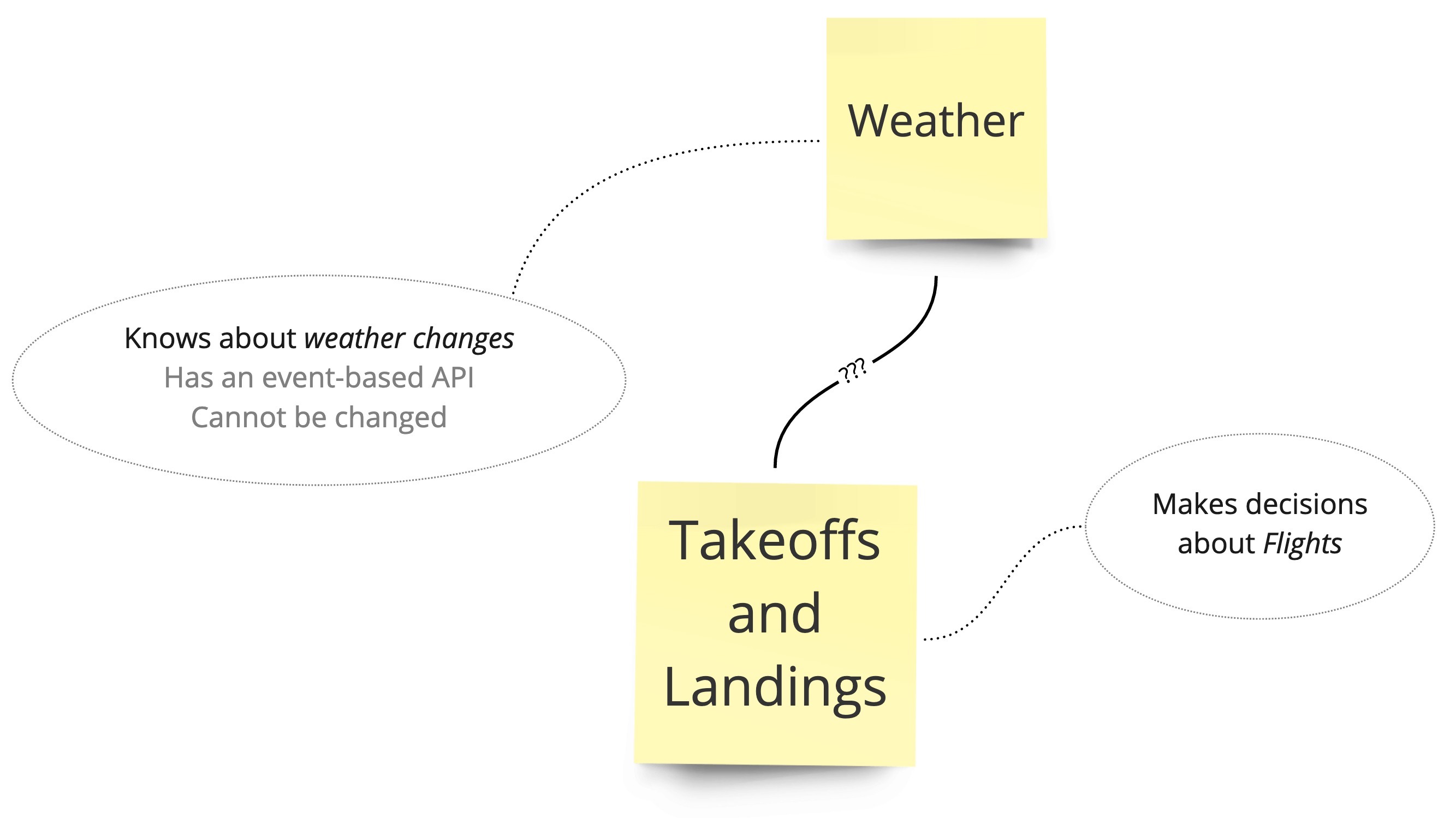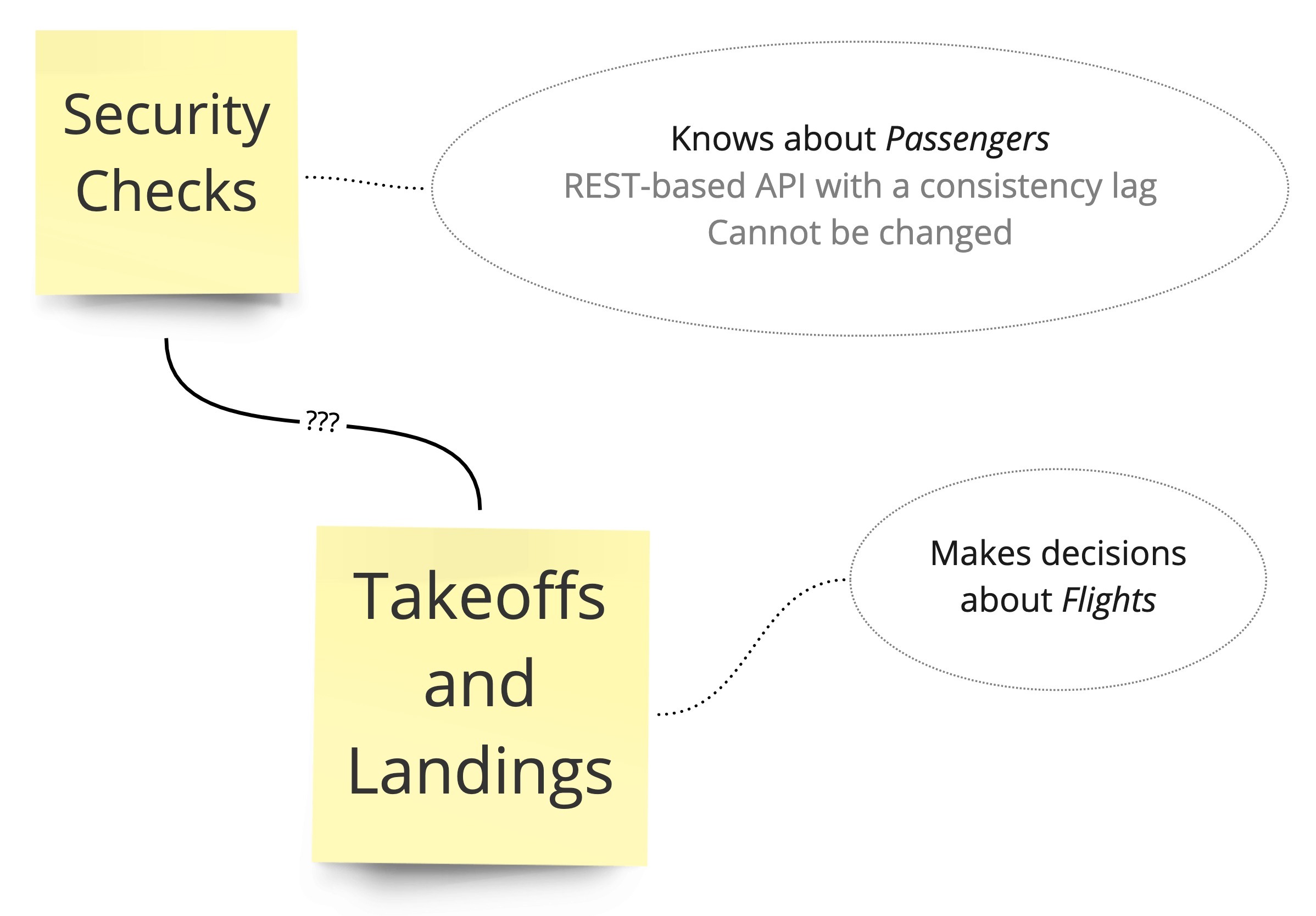Integration with a third party
When developing an Event-based system, it is often tricky to integrate it with other software, be it a third party or a legacy system.
In this article, we will explore the strategies of integrating third-party systems with your Spine-based Bounded Context.
Note that we think of a third-party system like of yet another Bounded Context with its own language. The terms “Bounded Context” and “System” are used interchangeably throughout the article.
To start the integration, your team should decide what portion of the other system’s domain model you should adopt and how exactly you want to isolate your system from the third party. In DDD terms, this means choosing the strategy of Context Mapping.
Context Mapping — TL;DR
For the purpose of this article, let’s consider only the technical (and not the organizational) aspect of a Context Map. You can read more about the concept as a whole in the “Domain-Driven Design” book by Eric Evans.
A Context Map, from a technical perspective, is the relationship between several Bounded Contexts. The book lists a few archetypes of a Context Map. Some of them are:
- Customer/Supplier Models, which establish an upstream-downstream relation. The Supplier team tailors its model specifically for the Customer model. For this strategy to work, the developers of both models have to collaborate.
- The Conformist pattern, which is very similar to the Customer/Supplier, except that the upstream is not available for change. Thus the downstream has to copy the language into its model thoughtlessly, hence conformism.
- Anticorruption Layer pattern (a.k.a. ACL), describing a Bounded Context, which is not willing to accept the language of the upstream and instead builds an intermediate model in the “no man’s land”. The ACL translates the language of the upstream into the native language of the downstream Context.
This list is not exhaustive. The “Domain-Driven Design” book offers a few more strategies, all worth considering. However, in this article, we are going to describe the listed three patterns, because they are the most commonly used.
The Domain

For the sake of an example, let’s consider airport management software. An airport is a complex system which relies on many people and much software working together. Let’s consider the system which helps the flight dispatchers make decisions on Takeoffs and Landings. The system integrates with the software responsible for Security Checks, Airplane Supplies, and Weather. All of these systems are independent of Takeoffs and Landings as well as of each other. Thus, each of them can be treated as a third party.
Disclaimer. The domain of an airport was chosen for being an “easy” example, familiar to many readers. The system reflects a general impression of an airport and should not be treated as an accurate representation.
Customer/Supplier Contexts

The Takeoffs and Landings system must know whether an Aircraft is ready for the Flight. This decision requires data on the supplies, which are provided for the Aircraft. To obtain this knowledge, the system integrates with the Airplane Supplies Context. Note the language difference between the Aircraft and an Airplane. Apparently, the two Contexts view the same entity of the real world from different perspectives. Airplane Supplies Context is an integral part of the airport software. Thus, by communicating with the developers responsible for Airplane Supplies, we are able to build a Customer/Supplier relationship between the Airplane Supplies Context and our system. The Airplane Supplies Context does not implement an Event-based messaging internally. However, it still acts as a Supplier. Specially for Takeoffs and Landings, the Supplier Context generates Events and publishes them to a shared channel. Takeoffs and Landings, the Customer, subscribes to those Events.
Note that those Events are specifically tailored to be consumed by our system, and thus we do not have to set up an elaborate Anticorruption Layer. However, a simple adapter is still required to parse and validate domain Events, which we then publish to a Bounded Context, implemented in Spine.
The Event Consumer, as depicted above, implements the Event transformation logic. In order to
establish this communication channel, the Airplane Supplies system declares a gRPC
service. In supplies_service.proto:
message Subscription {
string uuid = 1;
EventType event_type = 2;
google.protobuf.Timestamp starting_from = 3;
}
enum EventType {
ALL = 0;
PLANE_FUELED = 1;
ANTI_FROSTING_CHECK_COMPLETE = 2;
PREFLIGHT_CHECK_COMPLETE = 3;
}
The Airplane Supplies system implements the service and exposes it on an endpoint available to the Takeoffs and Landings system:
public final class SuppliesEventProducer extends SuppliesEventProducerImplBase {
...
@Override
public void subscribe(Subscription request, StreamObserver<SuppliesEvent> responseObserver) {
...
Timestamp timestamp = request.getStartingFrom();
historicalEvents
.stream()
.filter(event -> compare(event.getWhenOccurred(), timestamp) >= 0)
.filter(event -> matches(event, request.getEventType()))
.map(event -> event.toBuilder()
.setSubscription(request)
.build())
.onClose(responseObserver::onCompleted)
.forEach(responseObserver::onNext);
}
...
}
The event producer obtains cached historical events, matches them to the received subscription,
and sends them to the client. The Takeoffs and Landings system implements
an event consumer
which constructs a subscription and maintains it as long as the system needs to receive more events.
The consumer broadcasts the received Events via an instance of ThirdPartyContext:
@Override
public void onNext(SuppliesEvent event) {
Subscription eventSubscription = event.getSubscription();
checkArgument(subscription.equals(eventSubscription));
_fine().log("Received event `%s`.", eventSubscription.getEventType());
ActorContext actorContext = ActorContext
.newBuilder()
.setActor(ACTOR)
.setTimestamp(event.getWhenOccurred())
.vBuild();
EventMessage eventMessage = (EventMessage) unpack(event.getPayload());
context.emittedEvent(eventMessage, actorContext);
}
The AircraftAggregate
reacts on those events. Note that all the events published through ThirdPartyContext are always
external, so should be the subscriber and reactor methods.
@React
AircraftPreparedForFlight on(@External PreflightCheckComplete event) {
return AircraftPreparedForFlight
.newBuilder()
.setId(id())
.vBuild();
}
Conformist

Weather is an essential aspect of flying a plane, especially at low altitudes. The Weather Context wraps the data received from a meteorological station. This is a true third party to our system, as our organization, the airport, does not own it. Nearly all the details of a weather update are important to Takeoffs and Landings. The Weather Context forces Takeoffs and Landings to conform to its domain model.
The schema of the conformist relation looks somewhat like the Customer/Supplier schema. Similar to
the Customer/Supplier, Takeoffs and Landings Context is downstream from another Context, in this
case from Weather. Unlike the Customer/Supplier, Weather does not provide a specific
Event Producer, which would adapt Weather Events to the needs of Takeoffs and Landings.
Also, the Event Consumer on the Takeoffs and Landings side is rather thin and devoid of logic.
The Consumer consists of two parts: WeatherUpdateClient
and WeatherUpdateEndpoint.
The client polls the pull-style API of the Weather system.
private void fetchWeatherUpdates() {
Instant lastEvent = lastEventTime;
lastEventTime = Instant.now();
Request getEvents = new Request.Builder()
.get()
.url(weatherService.getSpec() + "/events?since=" + lastEvent.getEpochSecond())
.build();
try {
ResponseBody responseBody = client.newCall(getEvents)
.execute()
.body();
checkNotNull(responseBody);
String responseJson = responseBody.string();
WeatherMeasurement measurement = WeatherMeasurement.fromJson(responseJson);
endpoint.receiveNew(measurement);
} catch (IOException e) {
logger().atSevere()
.withCause(e)
.log();
}
}
The endpoint handles the polled measurements and publishes them as Events in the Takeoffs and Landings context:
public void receiveNew(WeatherMeasurement measurement) {
checkNotNull(measurement);
if (!previous.isUnknown()) {
TemperatureChanged event = TemperatureChanged
.newBuilder()
.setNewTemperature(measurement.toTemperature())
.setPreviousTemperature(measurement.toTemperature())
.vBuild();
weatherContext.emittedEvent(event, actor);
WindSpeedChanged event1 = WindSpeedChanged
.newBuilder()
.setNewSpeed(measurement.toWindSpeed())
.setPreviousSpeed(previous.toWindSpeed())
.vBuild();
weatherContext.emittedEvent(event1, actor);
}
previous = measurement;
}
The FlightAggregate
reacts on those events and changes its state as the result:
@React
EitherOf2<FlightRescheduled, Nothing> on(@External TemperatureChanged event) {
float newTemperature = event.getNewTemperature().getDegreesCelsius();
float previousTemperature = event.getPreviousTemperature().getDegreesCelsius();
if (abs(previousTemperature - newTemperature) > TEMPERATURE_CHANGE_THRESHOLD) {
return withA(postpone(QUARTER_OF_AN_HOUR));
} else {
return withB(nothing());
}
}
Anticorruption Layer

Security Checks Context has a rich model of its own. The system happens not to use domain Events at all. The Security Checks software, used in our airport, must go through a complex audit and certification process upon each change. Thus, the cost of changing it is too high. However, the Security Checks also happens to expose an API for fetching the current internal state of the system. The fetched state has a consistency lag, which never exceeds a known value (e.g. 2 minutes). In other words, the client of the Security Checks API can be sure that the received data was accurate at most 2 minutes before the query. Interaction with legacy software with known technical issues can be established with the help of an Anticorruption Layer. This pattern suggests that we cope with the problems, imposed by the legacy system, outside our domain model.
The Anticorruption Layer (ACL) acts as an interpreter from the language of Security Checks
Context into the language of Takeoffs and Landings Context. The ACL takes care of polling data
from the Security Checks API, filtering it out, transforming it into Events, which can be
understood by Takeoffs and Landings, etc.
The idea of an Anticorruption Layer may sound simple. In practice, this is a very powerful tool when
it comes to integrating with a third-party or legacy system. It is often used when splitting up
a large monolithic legacy system (a.k.a. a Big Ball of Mud) into Bounded Contexts. In those cases,
an ACL prevents the new “clean” Contexts from merging back into the Mud. If you are looking for
a way to add functionality to a complex legacy system without increasing the technical debt, look
no further. The Anticorruption Layer between Takeoffs and Landings and Security Checks
is composed of a polling client,
which performs all the technical work of obtaining and validating data, and a Process Manager
for the Boarding process.
The Security Checks API provides data for each passenger independently. The client polls
the data and publishes many intermediate PassengerBoarded or PassengerDeniedBoarding external
events via ThirdPartyContext:
public void start() {
while (active) {
Request request = requestPassengers();
try {
List<TsaPassenger> passengers = fetchPassengers(request);
passengers.forEach(this::emitIfStatusKnown);
} catch (IOException e) {
_warn().withCause(e)
.log();
}
sleepUninterruptibly(HALF_A_MINUTE);
}
}
private void emitIfStatusKnown(TsaPassenger tsaPassenger) {
BoardingStatus status = tsaPassenger.boardingStatus();
if (status == BOARDED) {
emitBoarded(tsaPassenger);
} else if (status == WILL_NOT_BE_BOARDED) {
emitDenied(tsaPassenger);
}
}
The Process Manager
accumulates the Events and, once the whole Flight is boarded, emits a BoardingComplete event,
which is later consumed by the Flight Aggregate.
@React
EitherOf2<BoardingComplete, Nothing> on(@External PassengerBoarded event) {
PassengerId passenger = event.getId();
builder().addBoarded(passenger);
return completeOrNothing();
}
@React
EitherOf2<BoardingComplete, Nothing> on(@External PassengerDeniedBoarding event) {
PassengerId passenger = event.getId();
builder().addWillNotBeBoarded(passenger);
return completeOrNothing();
}
In Conclusion
An integration job may seem complicated or even overwhelming. However, with a strong understanding of the domain and good tooling, the process boils down to a few simple steps. Indeed, it does not matter, whether you want to integrate with an outside system, your own legacy system, or reorganize your current system to work in an event-driven manner. A correct integration strategy will help you isolate and perfect your own domain language while on the work of many external systems. Read more about Bounded Contexts and their interactions in the “Domain-Driven Design” book by Eric Evans.
The full version of the source code used in this article could be found in the Airport Example repository.



